White Guys Always Win: The Allure and Legacy of Bruce Willisby Anthony Kaufman
By Yasmina Tawil
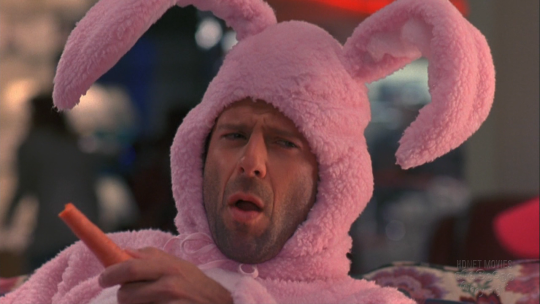
For many a boy of the 1980s, Bruce Willis was a profound (though slightly embarrassing) influence. Not nearly as macho or tough as other action stars of the Reagan-Bush years (Sylvester Stallone, Arnold Schwarzenegger, Mel Gibson), Willis derived much of his allure from his regular-guy-ness and quick wittedness. To be like Bruce, you didn’t need to spend hours in the gym or survive Vietnam; you just needed to have a shit-eating grin and a clever turn of phrase. For Willis’s enduring influence on a whole generation of boy-men, just see any episode of Brooklyn Nine-Nine, in which Andy Sandberg’s jokey cop delights in references to Die Hard (“Yippie Kayak, Other Buckets!”)
But Willis’s seemingly innocuous presence as a celebrity icon—and one who appears on the surface far less threatening than former Governor Schwarzenegger—masks a collection of potentially more insidious trappings than those famous hard-bodied men of Conservative America. So what might appear in Willis to be a possibly more sensitive, overly ironic, and even potentially progressive action-hero disguises the problematic ideological work his persona must exercise in order to thrive. Indeed, at the heart of Willis is a right-wing reactionary politics that has now bubbled up to the surface and swelled with age. But it wasn’t always so obvious.
Ever since the ‘80s, Willis has been a weaselly figure and hard to pin down—a Janus-faced star whose very celebrity has been erected on a foundation of duplicity. In the first episode of CBS’s 1985 The Twilight Zone reboot, Willis, in one of his first starring roles, played a man divided in two. The episode, called “Shatterday” and directed by Wes Craven, features Willis in a dual role, as an upper middle class white guy in crisis named Peter Jay Novins, and as his own mirror image, a second Peter who sabotages and subjugates the first one.
“Who are you? You’re not real,” the first Peter asks, speaking into a payphone. The other Peter, a cooler, more upstanding version of himself who sits comfortably in his apartment, responds, “What do you want me to say to that? I know I’m me. What are you?” It’s a good question to ask of Willis himself. Who is the second-rate actor and how and why has he endured for so many years as a male icon?
Reflecting much of his career, The Twilight Zone episode positioned Willis as a decidedly bifurcated man. Think also of Looper, another example of Willis’s double nature made manifest, in which his character is trying to survive being killed by a younger version of himself. Much of Willis’s success, in fact, comes from his uniquely slippery ability to portray an archetypical male hero, and all the baggage that come along with it, and empty it of meaning at the same time.
The Willis Smirk: Parody and Simulation
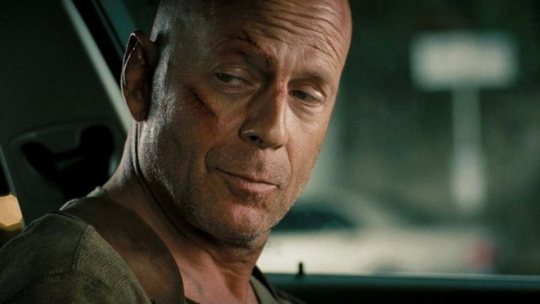
Willis’s early appeal lies in such posturing, as if he is “passing” for a macho-man. At the same time that Willis portrays the masculine, shirtless stud, firing various weapons at bad men, he’s also just a regular New Jersey guy with a receding hairline that’s playacting at “hero.” As Die Hard’s antagonist Hans Gruber intones, “Who are you exactly? Someone who watched too many action movies as a child and thinks he’s John Wayne, Rambo…?”
Willis’s trademark knowing smirk has always contained a hint of self-reflexivity, a sly recognition of his own falsehood. As one Newsweek reviewer wrote in 1995, “Willis is an engaging everyman. He looks like your plumber who can’t believe the john just exploded all over him.” Indeed, Willis often appears to be surprised by his own fame, cherishing it while it lasts, but knowing that the shit is eventually going to hit the fan. This simultaneous embodiment of self-promotion and self-parody takes its first major form in the actor’s Moonlighting career.
One of the show’s most famous aspects, of course, was acknowledging the fiction of the proceedings, with Willis’s character, David Addison, constantly breaking the fourth wall and directly addressing the audience. The TV viewer then gets to enjoy the media savvy bestowed upon them; they are party to his special in-jokes. Whether introducing episodes of the second season as both “David Addison” and “Bruce”; confronting the viewing audience with direct-address tongue-twisters; or stepping off the set and onto the soundstage, these early examples of self-reflexivity helped solidify Willis’s own “real-guy-ness” and lay the groundwork for the actor’s further adventures in Hollywood parody. In Die Hard 2 (1990), for example, Willis accidentally knocks into bad guy Colonel Stuart and remarks, “You have a familiar face.” When Stuart responds, “I’ve been on T.V.,” Willis retorts, “Me too.”
Die Hard 2 also features one of Willis’s most ludicrous action scenes, in which he ejects out of an exploding airplane. With the camera overhead looking down on the tarmac, the perspective shows Willis hurling up through the sky towards the viewer, screaming “Oh Shit!” in a comical display of crude matte-shot special effects and overt self-awareness. The supposedly explosive sequence is more punchline than awesomeness, further mocking Willis’s masculine heroism as well as the Hollywood spectacle in which his personae is half-assedly participating.
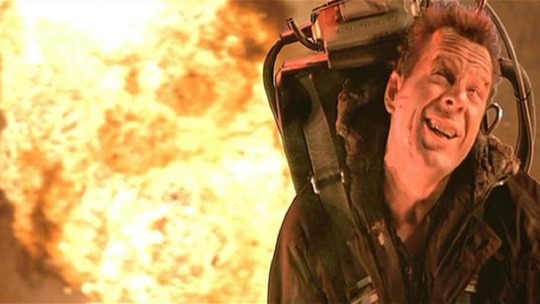
Such reflexivity wasn’t new in the late ‘80s/early ‘90s; see Ferris Bueller’s Day Off or The Last Action Hero. But for Willis, it became his identity, reappearing again in the intertextuality of the Die Hard movies (“How can the same shit happen to the same guy twice?” he asks in Die Hard 2) and the vast number of fiction films and TV shows in which Bruce Willis appears as himself (or some version of himself): The Player (1992), TV’s Mad About You (1997), Ocean’s Twelve (2004), Nancy Drew (2007), What Just Happened (2008), and I’m Still Here (2010). One of the entertainment industry’s running gags is to continually cast Willis as a parody of his own persona. By the time 2002’s The Expendables 2 rolls around, Willis and Schwarzenegger are exchanging “Yippie ki-yay” and “I’ll be back” taglines in an orgy of self-reflexivity that has become all-too-familiar.
While Willis continually plays tough-guy heroes (the Expendables and Red films), he also pokes fun at that very stereotype, revealing his masculine masquerade. Perhaps this is why he’s managed to survive as an action-hero well into his 60th year. Some critics may claim he isn’t credible as a middle-aged, gun-toting, ass-kicking dude, but they’re missing the point. Willis has never been credible—that’s his shtick.
Fittingly, Willis’s rise to fame parallels the popularization of postmodern theory. Fredric Jameson’s seminal essay, “Postmodernism, or, the Cultural Logic of Late Capitalism” was first published as an essay in the New Left Review in 1984, the year prior to Moonlighting, and was then published as a hugely influential book in 1991, a year after the release of the first Die Hard sequel. Jameson defined certain aspects of postmodernism that are eerily in sync with the Willis multiverse: the prominence of pastiche as well as a sense of dislocation. Writing about Los Angeles’ Westin Bonaventure Hotel, an analogue of Die Hard’s Nakatomi tower, Jameson famously wrote of its “reflective glass skin” that it “achieves a peculiar and placeless dissociation from its neighborhood…. It is not even an exterior, inasmuch as when you seek to look at the hotel’s outer walls you cannot see the hotel itself but only the distorted images of everything that surrounds it.“
Willis, himself, could be seen in a similar way. His persona exists as a purely superficial surface, which reflects a distorted image of the male action-hero.
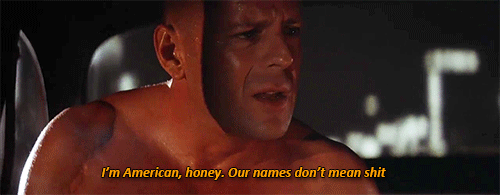
It’s no wonder Willis has been cast more than once by Quentin Tarantino, master of pastiche. The actor is perfectly suited to Tarantino’s pop-culture-infused universe, where the cinematic illusion is always on the verge of collapsing in on itself. In the Willis-starring sequence in Pulp Fiction, for instance, Willis’s Butch Coolidge looks almost directly into the camera, launching into a tirade about his girlfriend forgetting his most cherished watch. Willis isn’t exactly directly addressing the viewer, a la Moonlighting, but he might as well be, once again existing in that strange in-between space, somewhere between upholding and shattering the illusions of masculinity and the movies.
Populist/Enemy of the People
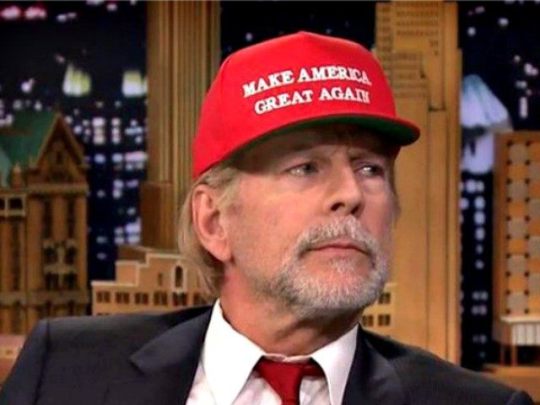
If Willis’s popularity comes, in part, from an acknowledgement that his whole tough-guy image is a charade, one with which we all get to laugh, there’s another duality at the center of his success that has more to do with politics. Throughout his action-hero films, Willis’s characters’ enemies are almost always representatives of the dominant elite white power structure. He is, then, supposedly a populist hero, fighting for the 99%.
Indeed, Willis’s prime targets in the action movies are either well-heeled nefarious masterminds (Die Hard’s Gruber; Die Hard with a Vengeance’s Simon Gruber; Live Free or Die Hard’s Thomas Gabriel; The Last Boy Scout’s Milo) or corrupt U.S. government officials (Die Hard 2’s Colonel Stewart; RED’s Vice President Robert Stanton, etc.). Who can stop these evil emissaries of the Military-Industrial-Corporate-Police-State-Government Complex? Who else, but Bruce Willis, working-class average Joe from Plainview, New Jersey. Even in Willis’s aforementioned Twilight Zone episode, it’s inferred that Willis’s original Peter Jay Novins is a corporate sleaze-ball, who is eventually vanquished by his more responsible and moralistic twin.
But if self-parody and populism are Willis’s main avenues for getting audiences on his side, this attraction comes at the expense of others. Because for Willis, who was never particularly leading-man handsome or strong, others need to be subdued so he can emerge as something special. Where would Willis be, for instance, without Moonlighting’s Maddie Hayes to mess with or the many women and girls he has been called upon to save? Whether daughters, lovers or eye-candy, young ladies-in-peril figure prominently in The Last Boy Scout, Hostage, Striking Distance, Live Free or Die Hard, Sin City, Cop Out, and RED.
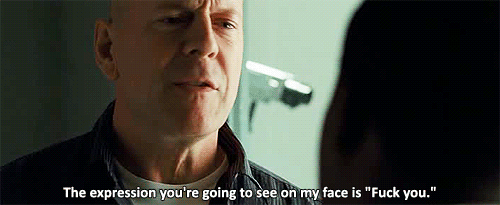
And where would Willis be without so many black “sidekicks” against which he inevitably shows off his supposedly superior masculine prowess? In Die Hard, the skinny hip-hop chauffeur Argyle and the pudgy donut-eating cop Sergeant Al Powell may help out McClane, but next to them, Willis’s sturdy New York cop is a stud. Even black men cast as buff and tough such as Ving Rhames’ Masellus Wallace (Pulp Fiction), Samuel L. Jackson’s Zeus Carver (Die Hard with a Vengeance) and Damon Wayans’ football player Jimmy Dix (The Last Boy Scout) need to be aided by Willis’s sword-wielding, shotgun-firing pseudo-macho men. In the more recent Cop Out (2010), itself an ode to buddy-cop comedies of the ‘80s, any pretense of black power is completely absent, with Willis’s straight-man sturdy policeman now paired with a completely buffoonish Tracy Morgan.
Thus, often situated in relation to a white career woman (who must be subdued) or a black man (who must be superseded), Willis’s power often emerges as a function of both her ridicule and his emasculation. As academics have argued, his white male dominance would have been especially under threat by these two marginalized groups in the ‘80s and ‘90s, who were perceived as encroaching upon white patriarchal hegemony at that time. Subordinating these groups is treated as essential for the white male action-hero’s survival. Thus, John McClane’s famous cowboy call “Yippee ki-yay, motherfucker!” is as much a cry of white male panic as witty one-liner, a brash, desperate attempt to re-assert his power in the face of its unraveling. After all, Willis’s cowboy is less John Wayne than the effeminate Roy Rogers (as he admits in Die Hard: “I really like those sequined shirts”).
Ultimately, this is Willis’s most ideologically dangerous dichotomy; all that postmodern parodying and populist underdog posturing is a comical cover for a deeply entrenched sexism and racism.
In recent years, Willis has begun to look more and more like the classic white male action hero and conservative patriot of the Reagan-Bush era (bulking up and going full bald). He’s played lots of tough dads and father figures in a series of B-grade actioners (Fire with Fire, The Cold Light of Day, Extraction) or antagonist crime bosses in second-rate genre films (Setup, Catch .44, The Prince, Vice).
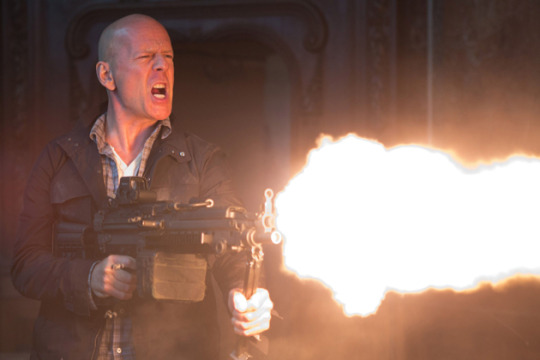
But the Willis hero continues to cling to whatever power he still possesses by subjugating and objectifying women most of all. In the final Die Hard movie, for instance, McClane levels his most rancorous and elaborate attack (and climactic confrontation, involving heavy vehicles) not against the film’s many Russian bad men, but Irina, the sexy Russian femme fatale, whose helicopter flies into a building in an attempt to kill McClane and his son. The stunt is a miraculous one; the result unsurprising: the woman explodes in a spectacular ball of flames, so McClane can finally form a cohesive male family unit with his studly white son, effectively passing off the torch to the next generation.
In this late phase of Willis’s career, composed mostly of the B-movies where he plays second fiddle to a young breed of hard-bodied GQ-chiseled Caucasian dudes (Kellan Lutz, Thomas Jane, Jai Courtney, Josh Duhamel, Henry Cavill), 1980s pastiche has given way to an un-ironic display of ripped motherfuckers, breaking the bones of bad guys with scantily-clad kick-ass chicks by their side. It’s almost as if they’ve reduced the smart-alecky Willis of Die Hard to what was always there in the first place, however cloaked in self-reflexivity and populist fun: A white guy who always wins.
This essay owes some of its academic rigor to the following sources: “From Pillar to Postmodernism: race, class, and gender in the male rampage film” (Fred Pfeil, Socialist Review, 1993); Spectacular Bodies: Gender, genre, and action cinema (Yvonne Tasker, 1993), “Restoring the Black Man’s Lethal Weapon: Race and Sexuality in Contemporary Cop Films” (Journal of Popular Film and Television, 1992).

